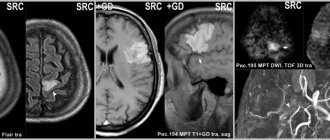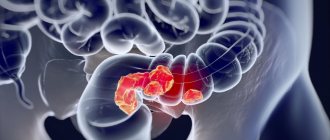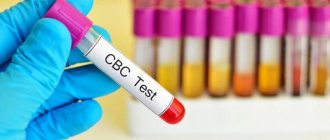Description of the disease
The thyroid gland begins to work already by the 12th week of intrauterine development, releasing three basic hormones into the body: thyroxine (T4), triiodothyronine (T3). They regulate the formation of organs and tissues, including the cerebral cortex, which is responsible for higher nervous activity.
The work of the gland and its participation in the regulation of various processes in the body continues throughout life, but in childhood it is especially important. Lack of hormones leads to delayed physical and mental development, delayed puberty, deterioration of metabolism and thermoregulation.
Classification of hypothyroidism in children
Depending on the mechanism of development, there are two main forms of hypothyroidism in children:
- congenital: present from the first day of life;
- acquired: formed after birth.
The level at which the failure occurred allows us to distinguish three types of pathology:
- primary: with this form of hypothyroidism in children, there is a malfunction of the thyroid gland itself;
- secondary: hypothyroidism is caused by a malfunction of the pituitary gland, which regulates the release of thyroid hormones;
- tertiary: caused by pathology of the hypothalamus, which is responsible for the functioning of the pituitary gland.
The third classification is based on the severity of symptoms of hypothyroidism in children:
- transient (transitory): problems arise periodically, then pass;
- subclinical: the amount of hormones in the blood is reduced, but there are no symptoms;
- manifest: there is both a hormone deficiency and symptoms of the disease.
Symptoms
At birth, symptoms may be vague and the first suspicions of pathology will become noticeable by 5-6 months of the baby’s life. This is due to the fact that hormone deficiency has varying degrees of severity. If the deficiency is severe at birth, then specialists will definitely pay attention to the jaundice and dryness of the baby’s skin, enlarged fontanel, and the baby will most likely weigh above average. If external signs are not noticeable initially and treatment is not started, then by 6 months the following may be observed:
- delays in physical and mental development;
- underdevelopment of many organs and systems;
- defects of the skin and mucous membranes, which are the result of impaired blood and lymph circulation or poor nutrition of body tissues.
In medicine, there are cases where congenital hypothyroidism in children manifests itself only at 5-6 years of age.
Causes of hypothyroidism in children
Among the causes that cause hypothyroidism in children of different ages, the most common are:
- malformations of the thyroid gland (absence, underdevelopment or displacement of the organ);
- exposure to ionizing radiation;
- chronic iodine deficiency;
- intrauterine infections;
- the presence of thyroid pathology in the mother at the time of pregnancy;
- taking a number of medications by the mother during pregnancy;
- abnormalities of the pituitary gland or hypothalamus;
- genetic defects in the synthesis of thyroid hormones or substances that regulate the functioning of the organ;
- inflammatory processes in the thyroid gland, hypothalamus, pituitary gland, as well as their injuries and tumors.
Forecast
If the pathology is detected early, the consequences of congenital hypothyroidism will not be detrimental to the patient’s health, but are assessed by doctors as favorable.
With proper therapy, bringing the main thyroid hormones to normal levels, we can say that nothing will hinder the child’s development (taking into account the fact that hormone replacement therapy will be lifelong).
If congenital hypothyroidism is detected not in the first months of life, but at 3-6, then the chances of complete normalization of the condition are significantly reduced, even with proper treatment. At the same time, it is possible to achieve the required level of psychophysical development of the child, but there is a high probability of lagging behind in intellectual development.
Symptoms of hypothyroidism in children
Signs of hypothyroidism in an infant are usually noticeable immediately after birth.
The baby has a lot of weight, swelling of the face and tongue, fingers and toes. The breathing of such babies is heavy, their voice is hoarse and rough. Doctors and parents often encounter prolonged jaundice in newborns, problems with healing of the umbilical wound, and the development of an umbilical hernia. As a rule, such children encounter problems during feeding due to a poorly developed sucking reflex. If a child is breastfed, even with congenital forms of hypothyroidism, its symptoms may not appear immediately. The deficiency is fully or partially compensated by maternal hormones, which the baby receives through milk. However, even in this case, delays in mental and physical development may gradually increase:
- decreased muscle tone;
- lethargy, immobility;
- retardation in height and weight;
- late closure of the fontanel;
- delayed teething;
- delay in the formation of basic skills (the ability to hold one's head up, roll over, sit down, stand, walk).
As a rule, a child with a deficiency of thyroid hormones is apathetic, has little interest in toys, and has poor contact with parents and others. He experiences dry skin, brittle hair, decreased immunity, and frequent constipation.
In children who are bottle-fed or mixed-fed, the signs of hypothyroidism progress faster, but much also depends on the form of the disease, its cause and the degree of deficiency. In mild cases, signs of deficiency are erased and begin to appear closer to school or even during puberty. The child has:
- excess body weight up to obesity, even against the background of moderate nutrition;
- growth retardation;
- delayed puberty;
- viscosity of thinking, deterioration in academic performance;
- lethargy, drowsiness, apathy, depressed mood.
In advanced cases, the consequences of hypothyroidism for the child are very severe: mental retardation, skeletal deformation, hearing and speech disorders, and underdevelopment of the reproductive system develop.
Diagnosis of hypothyroidism
A pediatric endocrinologist diagnoses hypothyroidism in children. The examination is aimed at timely detection of hormone deficiency, determining the form and cause of the disease. All newborn babies are required to have their thyroid-stimulating hormone (TSH) levels checked on days 4-5 of life. If it is in excess, a preliminary diagnosis of hypothyroidism is made.
An extensive laboratory examination includes determination of the level of hormones T3, T4, thyreglobulin, hormone binding index, detection of antibodies to thyroid hormones, and a test with thyrotropin-releasing hormone to assess the functioning of the pituitary gland.
In addition to tests, other diagnostic procedures are used: ultrasound and scintigraphy of the thyroid gland, determination of bone age (by x-ray of the knee joints, feet, hands), MRI or CT of the sella turcica, heart examinations (ECG, ultrasound) in the presence of related problems. If necessary, the child is referred for consultations to specialized specialists: ophthalmologist, neurosurgeon, neurologist, cardiologist, hematologist, etc.
CONGENITAL HYPOTHYROIDSIS
Congenital hypothyroidism (CH) is a disease of the thyroid gland that occurs with a frequency of 1 case in 4000–5000 newborns. In girls, the disease is detected 2–2.5 times more often than in boys.
The disease is based on a complete or partial deficiency of thyroid hormones produced by the thyroid gland, which leads to a delay in the development of all organs and systems. First of all, the central nervous system suffers from a lack of thyroid hormones. A direct connection has been established between the age at which treatment was started and the index of the child’s intellectual development in the future. Favorable (adequate) mental development can be expected only if replacement therapy was started in the first month of the child’s life.
It is possible to make a timely diagnosis and, therefore, start treatment on time only by conducting an early (in the first days of life) examination of all newborns.
Mass examination (screening) for congenital hypothyroidism was first carried out in Canada in 1971. Today, this is a common method of examination in most developed countries. In Russia, similar screening has been carried out over the past 12 years.
The basic principles of neonatal screening for CH are as follows. All variants of congenital hypothyroidism are accompanied by low levels of thyroid hormones (T4, T3); increased levels of thyroid-stimulating hormone (TSH) are characteristic of primary hypothyroidism. But since it represents the most common variant of the disease (up to 90% of all cases), in most countries the basis of screening is the determination of TSH. In the USA and Canada, screening is based on T4 determination. It would be optimal to determine both parameters, but this significantly increases the cost of the examination.
The main goal of screening for congenital hypothyroidism is the early detection of all newborns with elevated TSH levels in the blood. All newborns with abnormally high TSH require urgent in-depth examination for final diagnosis of the disease and immediate initiation of replacement therapy (optimally in the first 3 weeks of life).
Blood is taken from all newborns on the 4th–5th day of life (for premature babies on the 7th–14th day of life) (usually from the heel) and 6–8 drops are applied to special porous filter paper. The obtained and dried blood samples are sent to a specialized laboratory where TSH is determined.
The concentration of TSH depends on the method of determination. The threshold level of TSH is subject to fluctuations and is set separately for each laboratory, depending on the chosen method of determination. Most laboratories work with Delphi diagnostic kits, for which the threshold TSH level is 20 mU/l. Thus, all TSH samples up to 20 mU/l are a variant of the norm. All samples with a TSH concentration above 20 mU/L should be retested, TSH concentrations above 50 mU/L suggest hypothyroidism, and TSH levels above 100 mU/L are highly suggestive of the disease. Therefore, it is necessary to urgently clarify the diagnosis in all newborns with a TSH level above 20 mU/l; this is possible by repeated blood sampling and determination of TSH and St. levels. T4 in blood serum.
After taking blood, children with a TSH level above 50 mU/l are immediately (without waiting for the results) prescribed levothyroxine replacement therapy (euthyroxine, L-thyroxine, thyro-4, L-thyrox, L-thyroxine-Acri, L-thyroxine-Farmak) . Treatment may be discontinued after normal results are obtained. T4 and TSH.
The question of prescribing treatment for children with TSH levels of 20–50 mU/l is decided after re-donating blood and obtaining TSH and St. levels. T4.
Children for whom treatment was not immediately prescribed require repeated examinations to determine TSH and T4 levels (in a week, then in a month), and if the TSH level increases, replacement therapy with thyroid drugs should be prescribed with further careful monitoring of the child.
Etiology of congenital hypothyroidism
Congenital hypothyroidism is a fairly heterogeneous group of diseases in etiology, caused by the morphofunctional immaturity of the hypothalamic-pituitary system, the thyroid gland or their anatomical damage in the prenatal period.
In recent years, due to the development of molecular genetic analysis methods, views on the etiology of congenital hypothyroidism have changed in many ways. In the vast majority of cases (85–90%), primary congenital hypothyroidism occurs. Approximately 85% of cases of primary hypothyroidism are sporadic, 15% are hereditary. Most sporadic cases are caused by thyroid dysgenesis, and cases of ectopic thyroid gland are more common than complete absence (agenesis) or hypoplasia of the thyroid gland. According to various authors, agenesis of the thyroid gland occurs in 22–42% of cases, thyroid tissue is ectopic in 35–42%, and hypoplasia of the thyroid gland occurs in 24–36% of cases.
Thyroid dysgenesis is likely to be caused by both genetic and environmental factors, but its molecular basis is still poorly understood. To date, 3 transcription factors involved in the formation and differentiation of the thyroid gland have been identified: PAX-8 (paired domain homeobox), TTF-1 and TTF-2 (thyroid transcription factors 1 and 2). An experiment on mice showed the role of TTF-1 in the presence of agenesis of the thyroid gland, severe defects of the lungs and anterior parts of the brain. The TTF-1 gene is localized in the 14q13 region.
TTF-2 is required for normal thyroid morphogenesis. The participation of TTF-2 in the migration of the thyroid gland and the overgrowth of the hard palate has been experimentally proven. In addition, TTF-2 regulates the expression of thyroglobulin and thyroid peroxidase in the thyroid gland, as does PAX-8.
Most familial cases of CH are congenital “errors” that impair the synthesis of T4 or its binding to target organs; this variant of the disease most often manifests as a congenital goiter. Today, the following congenital disorders of hormonogenesis in the thyroid gland are known: decreased sensitivity to thyroid-stimulating hormone; lack of ability to concentrate iodide; violation of iodine organization (due to defects in peroxidase or the system generating H2O2); iodotyrosine deiodinase disorder; violation of the synthesis or transport of thyroglobulin.
| Apgar score for diagnosing congenital hypothyroidism in newborns |
Mutations in the thyroid peroxidase and thyroglobulin genes have been described. The absence of thyroid peroxidase activity leads to a decrease in the uptake of iodide by thyrocytes, disruption of the processes of organification of iodides, which, in turn, leads to a decrease in the synthesis of thyroid hormones. Newborns with enzymatic defects of TPO have very high TSH levels and very low T4 levels at birth, and subsequently develop a goiter.
Much less common (5–10% of cases) occurs secondary congenital hypothyroidism, manifested by an isolated deficiency of TSH synthesis or hypopituitarism. In some cases, the cause of secondary hypothyroidism is a defect in the Pit-1 gene - pituitary-specific transcription factor-1, mutations in which cause a combined deficiency of growth hormone, prolactin and thyroid-stimulating hormone. The role of a defect in the Prop-1 gene, a transcription factor that causes a deficiency of not only TSH, GH and prolactin, but also gonadotropins, is being studied.
Congenital isolated TSH deficiency is a very rare autosomal recessive disorder caused by mutations in the TSH gene. We present the most common classification of causes of congenital hypothyroidism today.
Primary
- Thyroid dysgenesis: agenesis (atherosis); hypogenesis (hypoplasia); dystopia.
- Disorders of hormonogenesis in the thyroid gland: deficiency (defect) of TSH receptors; iodide transport defect; defect of the peroxidase system; defect in the synthesis or transport of thyroglobulin; iodotyrosine deiodinase disorder.
Secondary
- Panhypopituitarism.
- Isolated deficiency of TSH synthesis.
Resistance to thyroid hormones. Transient hypothyroidism
- Drug-induced hypothyroidism (mother taking antithyroid drugs).
- Hypothyroidism induced by maternal antibodies that block TSH receptors.
- Exposure to iodine in the pre- or postnatal period.
Diagnosis of congenital hypothyroidism
Before the era of screening for congenital hypothyroidism and the widespread introduction into clinical practice of radioimmunological methods for determining hormones in blood serum, the diagnosis of CH was made on the basis of clinical and anamnestic data, which explained the rather late start of replacement therapy.
The typical clinical picture of congenital hypothyroidism in newborns and children in the first month of life, when it is extremely important to make a diagnosis, is observed in only 10–15% of cases. The most typical signs of the disease in the early postnatal period are: post-term pregnancy (more than 40 weeks); high birth weight (more than 3500 g); swollen face, lips, eyelids, half-open mouth with a wide, “spread out” tongue; localized swelling in the form of dense “pads” in the supraclavicular fossa, dorsal surfaces of the hands, feet; signs of immaturity in a full-term pregnancy; low, rough voice when crying, screaming; late passage of meconium; late departure of the umbilical cord, poor epithelization of the umbilical wound; prolonged jaundice.
Subsequently, in the 3rd–4th month of life, if treatment is not started, other clinical symptoms of the disease appear: decreased appetite, difficulty swallowing, poor weight gain; flatulence, constipation; dryness, pallor, peeling of the skin; hypothermia (cold hands, feet); brittle, dry, dull hair; muscle hypotonia.
At a later date, after the 5th–6th month of life, an increasing delay in the psychomotor and physical development of the child and delayed teething come to the fore.
Body proportions in children with hypothyroidism approach chondrodystrophic, the development of the facial skeleton lags behind (wide sunken bridge of the nose, hypertelorism, late closure of the fontanelles). The eruption and later the change of teeth are delayed. Noteworthy are cardiomegaly, dullness of heart sounds, decreased blood pressure, decreased pulse pressure, and bradycardia (in children of the first months, the pulse rate may be normal). Children with congenital hypothyroidism are characterized by a low, rough voice; they often have cyanosis of the nasolabial triangle and stridor breathing.
Summarizing the above clinical signs of congenital hypothyroidism, we present the Apgar score, which helps in early clinical screening of CH (Table). However, only screening for congenital hypothyroidism makes it possible to make a diagnosis in the first days of a child’s life, before a detailed clinical picture of the disease appears, and thus avoid the severe consequences of the disease, the main of which are delayed mental and physical development of the child. Economically, the cost of screening and the cost of treating a disabled child in late diagnosed cases are related as 1:4.
Replacement therapy with levothyroxine sodium
Monitoring of children with CH in the first year of life should be carried out by an endocrinologist, pediatrician, or neurologist.
Control blood samples are taken 2 weeks and 1.5 months after the start of replacement therapy. It is necessary to constantly keep in mind the possibility of an overdose of levothyroxine sodium. The dosage of levothyroxine sodium is selected individually, taking into account clinical and laboratory data.
In children of the first year of life, it is necessary to primarily focus on the T4 level, since in the first months of life there may be a disruption in the regulation of TSH secretion according to the feedback principle. Assessing TSH levels alone may lead to the prescription of unnecessarily large doses of levothyroxine sodium. In cases of relatively high TSH levels and normal levels of total T4 or St. The T4 dose of levothyroxine sodium may be considered adequate. Further control determinations of the concentration of TSH and T4 levels should be carried out in the first year of life every 2-3 months of life, after a year - every 3-4 months.
Thus, immediately after the diagnosis is established, as well as in doubtful cases, replacement therapy with sodium levothyroxine preparations (euthyrox, L-thyroxine, thyro-4, L-thyrok, L-thyroxine-Acri, L-thyroxine-Farmak) should be started. Treatment in most countries begins no later than the first month of life, on average at the 2nd week, for example in Germany treatment begins on the 8–9th day of life, in the UK - on the 11–15th day.
The first-line drug for the treatment of congenital hypothyroidism is levothyroxine sodium. The drug can be produced in various dosages - 25, 50 and 100 mcg in one tablet. It is important to draw the attention of parents to the presence of different dosages of drugs and indicate the prescribed dose of levothyroxine in mcg, and not just in parts of the tablet.
Levothyroxine is completely identical to the natural human hormone thyroxine, which is its main advantage over other synthetic drugs. In addition, after taking levothyroxine (euthyroxine, L-thyroxine, thyro-4, L-thyrox, L-thyroxine-Acri, L-thyroxine-Farmak), a “depot” of this drug is created in the blood, which is consumed as needed by deiodination of thyroxine and turning it into T3. In this way, high, peak levels of triiodothyronine in the blood are avoided.
The entire daily dose should be given in the morning 30 minutes before breakfast, with a small amount of liquid. For young children, the drug should be prescribed during morning feeding, in crushed form.
The initial dosage of levothyroxine is 12.5–25–50 mcg/day or 10–15 mcg/kg/day. In addition, the child's need for thyroid hormones correlates with body surface area. It is recommended to prescribe levothyroxine at a dose of 150–200 mcg/m2 of body surface area for newborns, and 100–150 mcg/m2 for children over one year of age.
Taking into account the clinical symptoms, it should nevertheless be remembered that the most reliable indicator of the adequacy of the treatment received by a child for hypothyroidism is the normal level of TSH in the blood serum, and in children of the first year of life - thyroxine levels. It should be taken into account that the T4 level usually normalizes 1–2 weeks after the start of treatment, the TSH level 3–4 weeks after the start of replacement therapy. During long-term treatment, indicators of the adequacy of the dose of levothyroxine sodium used are data on growth dynamics, general development of the child, and indicators of skeletal differentiation.
V. A. Peterkova , Professor, Doctor of Medical Sciences O. B. Bezlepkina , Candidate of Medical Sciences, State Research Center of the Russian Academy of Medical Sciences, Moscow
Treatment of hypothyroidism in children
Treatment of hypothyroidism in children is aimed not only at eliminating specific symptoms, but also at eliminating the cause of the disease, if possible.
The main method of therapy is to compensate for the deficiency by taking hormones. The dose of the drug is selected individually and adjusted as necessary. If doctors are unable to eliminate the cause of hypothyroidism, replacement therapy will be lifelong. Additionally, various general strengthening measures are prescribed: massage, exercise therapy, good nutrition with a sufficient amount of vitamins, nootropic drugs for developmental delays, etc.
Which doctor will help?
The treatment of congenital hypothyroidism in children is carried out by an endocrinologist together with a pediatrician.
I, Georgy Nikitich Romanov, am a qualified and experienced endocrinologist. My medical practice spans more than 20 years, during which time I have encountered various cases, including a disease such as congenital hypothyroidism, with which we successfully worked.
I acquired my skills not only at universities in our country, but also abroad (I completed internships in the UK, Germany, and Russia). The skills and experience I have gained help me accurately prescribe treatments for my patients.
At the moment, I am conducting face-to-face appointments at the Amadeus Clinic medical center in Gomel and conducting paid online consultations. As part of an online consultation, I can evaluate diagnostic results, treatment progress, adjust treatment, and more.
To sign up for a consultation, write to me in one of the suggested messengers: Viber, Skype, Instagram, VKontakte, WhatsApp.
Prevention and prognosis for hypothyroidism in children
The prognosis for hypothyroidism in children depends on the form of the disease, the level of thyroid hormones in the blood, and the timeliness of detection of the deficiency. With timely administration of hormone replacement therapy, the child grows and develops in accordance with the norms. If the disease is discovered late, a complete cure is unlikely, since many disorders become irreversible.
Prevention of hypothyroidism in children consists of the preventive use of iodine preparations during pregnancy, monitoring the level of thyroid hormones in the expectant mother, and then in the child himself. If there is a predisposition to the disease, control should be especially strict even in the absence of problems.
The earlier your child's hypothyroidism is detected, the fewer problems he will experience due to hormone deficiency. Pediatric endocrinologists at the SM-Doctor clinic will conduct an appointment, assess the baby’s condition, and prescribe the necessary examinations and treatment. Make an appointment at the slightest suspicion of hormonal deficiency.
Consequences of the disease
The consequences of insufficient thyroid hormone production can be catastrophic for a child without the necessary treatment.
Consequences of congenital hypothyroidism:
- delay in physical, emotional and intellectual development;
- since thyroid hormones affect the functioning of many organs, we can talk about emerging pathologies also from the heart, nervous system and psyche;
- in advanced cases, myxedema occurs (insufficiency of thyroid hormones in tissues and other organs), which leads to the patient’s coma.
Dear patients, in our medical center you can do an ultrasound of the thyroid gland.










